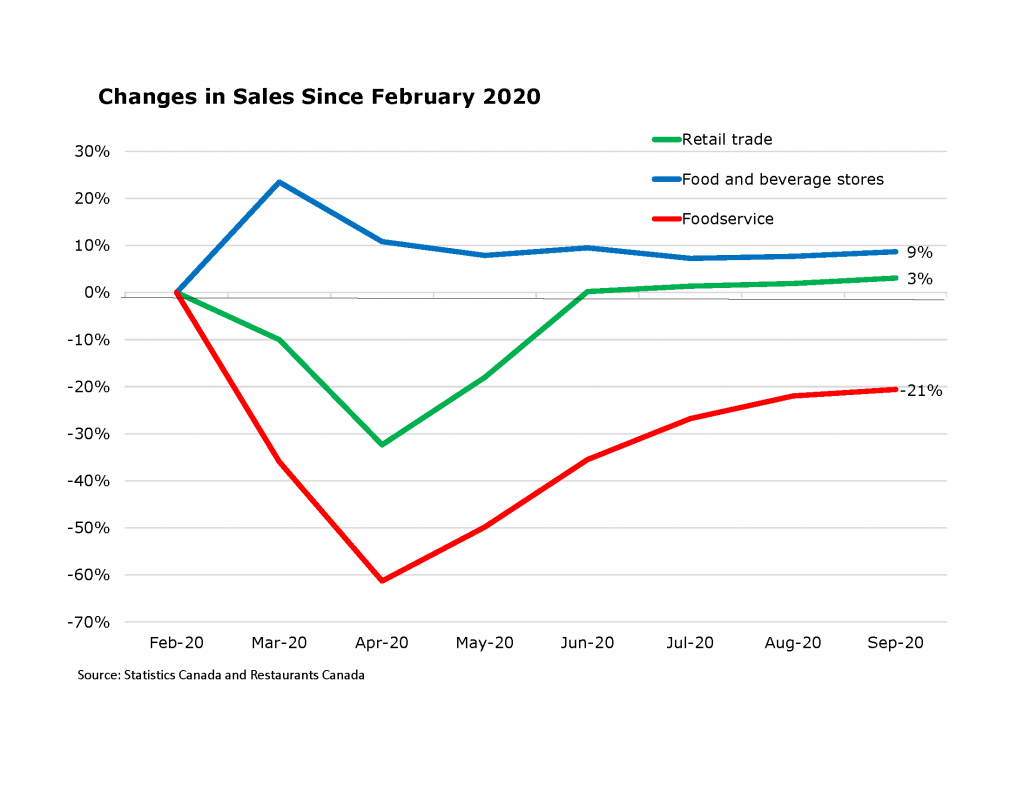2020: A Year in Review (Part 1)
The following is part one of a two-part series about the state of Canada’s foodservice industry. In part one, we take a look back at the seismic transformation of the foodservice landscape in 2020 due to COVID-19 and what lessons were learned for the years ahead. Part two reviews our upcoming forecast for foodservice sales in 2021 and beyond – read it here.
It seems almost impossible to summarize 2020 in a 700-word article. This was a year in which we experienced unprecedented sales declines and massive restaurant closures. Despite ongoing government intervention with the wage and rent subsidy programs, the industry has been pushed to the brink of collapse with many foodservice businesses operating at a loss.
Looking back at the beginning of this crisis, foodservice sales tumbled by a staggering 61% in March and April 2020 compared to February 2020. This marked the lowest monthly foodservice sales in over two decades.

Although there has been some improvement in foodservice sales, the dramatic decline in tourism and business spending, combined with consumers reluctant to dine in-doors, are restraining the recovery. In September, sales remained 21% below February 2020 levels. Full-service restaurant and drinking place sales are down 26% and 36% respectively. Meanwhile, retail stores returned to pre-COVID levels in June and are currently 3% above February 2020 levels. With the recent lockdowns in Toronto and Peel regions in Ontario, combined with other regions across the country clamping down on the spread of coronavirus, foodservice remains among the hardest-hit industries.
While Statistics Canada has been unable to capture these closures at the time of this writing, preliminary estimates from the industry point to the permanent closure of nearly 10,000 restaurants, caterers, and drinking places across the country due to COVID-19. This represents roughly one in 10 locations.
2020 was expected to be a challenging year, even before COVID-19. In last year’s Restaurants Canada’s 2019-2023 Long Term Foodservice Forecast report, Hugh Johnston from Strategic and Financial Architect, provided key business insights for foodservice operators. His sage advice: simplify and diversify. He wrote:
“There is nothing like being “meat ‘n’ potatoes” to make it through a recession, even if it seems boring. As they say, “people gotta eat.” Expense account dining is a time bomb in a recession, and vacation spending is vulnerable, too. If these segments are at the core of your business model, get ready for a more challenging ride, and plan accordingly.”
This was written at a time when COVID-19 wasn’t on anyone’s radar. Back then, the economy was expected to slow down or even fall into a mild recession. Looking back, these words apply as much to today’s foodservice landscape as ever.
Restaurant operators did simplify and diversify. Many simplified their menus to streamline their operation and reduce costs without reducing brand standards. Rather than trying to be all things to all people, restaurants focused on their core business strengths.
There was also radical diversification as many restaurants pivoted by adding groceries or meal kits. In terms of groceries, it went beyond carrying items like produce and bread, but also pre-made fresh and frozen dishes. Meal kits were another innovation for guests to try easy-to-make-at-home meals. They also released signature dishes and sauces as another source of revenue and ensure greater brand reach.
Diversification also changed how people interacted with guests. With people reluctant to eat on-premise, restaurants found new ways to shift that personal indoor dining experience onto an online platform. A number of operators and chefs had positive feedback when they used their YouTube and Instagram channels to share videos about how to cook and prepare food and the changes they were making to keep guests safe and healthy.
Prior to COVID-19, delivery was the fastest-growing area of the foodservice industry. Between 2016 and 2019, delivery soared by 85% compared to a 3% increase in on-premise dining according to Ipsos Foodservice Monitor. Many of those that didn’t offer delivery before the crisis, quickly pivoted to delivery when on-premise dining was shut down. This includes provincial governments allowing the delivery of alcohol with food for the first time. At its peak, delivery accounted for roughly one-quarter of sales at restaurants. While this has moderated somewhat, delivery is here to stay.
2020 will be remembered for the devastating impact COVID-19 had on the foodservice industry. Despite all the doom and gloom, however, 2020 should also be remembered for the amount of radical innovation that took place by foodservice operators. This is what saved many restaurants from shutting down permanently during the dark days of COVID-19. We saw foodservice operators usher in new changes, such as groceries and meal kits; restaurants embracing delivery and takeout; and the acceleration of ghost kitchens. Without these changes, the industry would have seen even more closures. In addition, these changes will have a long-lasting impact on the industry in the years to come.









